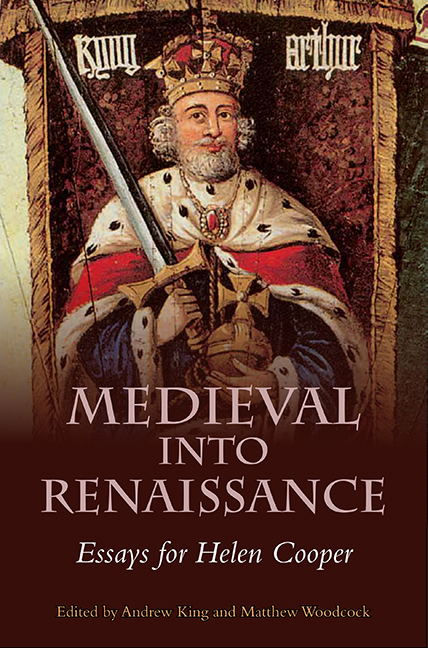53 results
6 - Charlemagne in Ireland: Manuscripts and Audiences
-
-
- Book:
- Charlemagne in the Norse and Celtic Worlds
- Published by:
- Boydell & Brewer
- Published online:
- 08 June 2023
- Print publication:
- 13 December 2022, pp 113-131
-
- Chapter
- Export citation
10 - Between Epic and Romance: The Matter of England and the Chansons de Geste
-
-
- Book:
- Cultural Translations in Medieval Romance
- Published by:
- Boydell & Brewer
- Published online:
- 07 October 2022
- Print publication:
- 14 January 2022, pp 191-208
-
- Chapter
- Export citation
3 - The Island of Sicily and the Matter of Britain
-
-
- Book:
- Medieval Romance, Arthurian Literature
- Published by:
- Boydell & Brewer
- Published online:
- 20 December 2023
- Print publication:
- 15 October 2021, pp 34-45
-
- Chapter
- Export citation
What can researchers learn from participant involvement? Insights from the ROLO Family Advisory Committee
-
- Journal:
- Proceedings of the Nutrition Society / Volume 79 / Issue OCE2 / 2020
- Published online by Cambridge University Press:
- 10 June 2020, E541
-
- Article
-
- You have access
- Export citation
A systematic review of probiotic use to improve metabolic health in women
-
- Journal:
- Proceedings of the Nutrition Society / Volume 79 / Issue OCE2 / 2020
- Published online by Cambridge University Press:
- 10 June 2020, E656
-
- Article
-
- You have access
- Export citation
The association between the maternal diet and the maternal and infant gut microbiome: a systematic review
-
- Journal:
- British Journal of Nutrition / Volume 129 / Issue 9 / 14 May 2023
- Published online by Cambridge University Press:
- 04 March 2020, pp. 1491-1499
- Print publication:
- 14 May 2023
-
- Article
-
- You have access
- Open access
- HTML
- Export citation
New directions in medieval manuscript studies and reading practices. Essays in honor of Derek Pearsall. Edited by Kathryn Kerby-Fulton, John J. Thompson and Sarah Baechle. Pp. xxii + 551incl. frontispiece and 39 black-and-white and colour ills. Notre Dame, In: University of Notre Dame Press, 2014. $66. 978 0 268 03327 9
-
- Journal:
- The Journal of Ecclesiastical History / Volume 67 / Issue 3 / July 2016
- Published online by Cambridge University Press:
- 10 June 2016, pp. 624-626
- Print publication:
- July 2016
-
- Article
- Export citation

Medieval into Renaissance
- Essays for Helen Cooper
-
- Published by:
- Boydell & Brewer
- Published online:
- 05 July 2016
- Print publication:
- 19 May 2016
Contents
-
- Book:
- Medieval into Renaissance
- Published by:
- Boydell & Brewer
- Published online:
- 05 July 2016
- Print publication:
- 19 May 2016, pp v-vi
-
- Chapter
- Export citation
Acknowledgments
-
- Book:
- Medieval into Renaissance
- Published by:
- Boydell & Brewer
- Published online:
- 05 July 2016
- Print publication:
- 19 May 2016, pp ix-ix
-
- Chapter
- Export citation
Bibliography
-
- Book:
- Medieval into Renaissance
- Published by:
- Boydell & Brewer
- Published online:
- 05 July 2016
- Print publication:
- 19 May 2016, pp 251-272
-
- Chapter
- Export citation
Abbreviations
-
- Book:
- Medieval into Renaissance
- Published by:
- Boydell & Brewer
- Published online:
- 05 July 2016
- Print publication:
- 19 May 2016, pp x-x
-
- Chapter
- Export citation
A Bibliography of Helen Cooper's Published Works
-
- Book:
- Medieval into Renaissance
- Published by:
- Boydell & Brewer
- Published online:
- 05 July 2016
- Print publication:
- 19 May 2016, pp 279-284
-
- Chapter
- Export citation
List of Illustrations
-
- Book:
- Medieval into Renaissance
- Published by:
- Boydell & Brewer
- Published online:
- 05 July 2016
- Print publication:
- 19 May 2016, pp vii-vii
-
- Chapter
- Export citation
Index
-
- Book:
- Medieval into Renaissance
- Published by:
- Boydell & Brewer
- Published online:
- 05 July 2016
- Print publication:
- 19 May 2016, pp 273-278
-
- Chapter
- Export citation
List of Contributors
-
- Book:
- Medieval into Renaissance
- Published by:
- Boydell & Brewer
- Published online:
- 05 July 2016
- Print publication:
- 19 May 2016, pp viii-viii
-
- Chapter
- Export citation
Tabula Gratulatoria
-
- Book:
- Medieval into Renaissance
- Published by:
- Boydell & Brewer
- Published online:
- 05 July 2016
- Print publication:
- 19 May 2016, pp 285-285
-
- Chapter
- Export citation
Writing Westwards: Medieval English Romances and their Early Modern Irish Audiences
-
-
- Book:
- Medieval into Renaissance
- Published by:
- Boydell & Brewer
- Published online:
- 05 July 2016
- Print publication:
- 19 May 2016, pp 73-90
-
- Chapter
- Export citation
Frontmatter
-
- Book:
- Medieval into Renaissance
- Published by:
- Boydell & Brewer
- Published online:
- 05 July 2016
- Print publication:
- 19 May 2016, pp i-iv
-
- Chapter
- Export citation
Abbreviations
-
- Book:
- Medieval Romance and Material Culture
- Published by:
- Boydell & Brewer
- Published online:
- 05 May 2015
- Print publication:
- 16 April 2015, pp xiii-xiv
-
- Chapter
- Export citation



